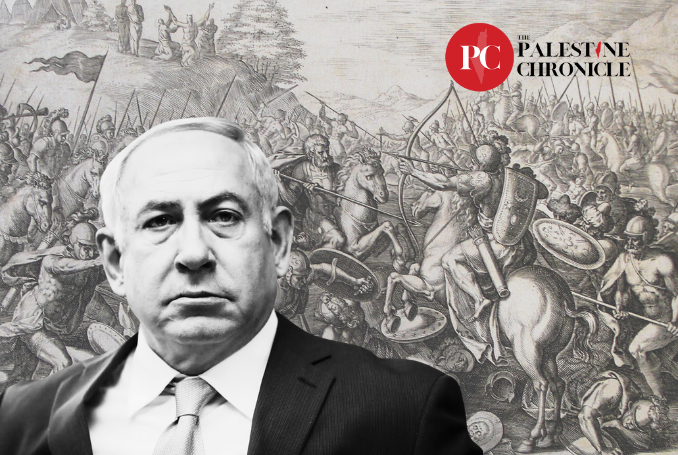
By Jeremy Salt
Centuries later, this battle order is being followed up in Gaza, where the death and destruction also include the deliberate killing of men and women, children and infants, through starvation and disease.
Benjamin Netanyahu’s use of Amalek as a Biblical metaphor for the destruction of Gaza attracted international condemnation. It was a prescription for genocide, which, looking back on the past five months, Israel has “plausibly” been carrying out, in the judgment of the International Court of Justice (ICJ).
Living in the desert on the outskirts of the land of Canaan, the Amalekites (the followers of Amalek, a tribal or clan chief of ancient Biblical lineage) were the first enemies of the Israelites.
They were defeated under the command of Joshua bin Nun. Thus, threatened at the outset, the destruction of the Amalekites served as the template for the ruthless extirpation of all of Israel’s enemies in the land of Canaan, the Philistines among them.
The Israelites were commanded by God to wipe them all off the face of the earth, to “totally destroy all that belongs to them … do not spare them; put to death men and women, children and infants, cattle and sheep, camels and donkeys.”
Centuries later, this battle order is being followed up in Gaza, where the death and destruction also include the deliberate killing of men and women, children and infants, through starvation and disease.
The Bible might be a dead text to the non-religious, a book of myth, not history, with no relevance to their daily lives, but for the religious it is living history and, for the messianic-minded, a blueprint for the present and the future. The connection is especially important in the US, where a powerful Christian Zionist lobby watches over Israel’s interests year after year.
While the roots of Christian Zionism can be traced back to the 16th century, only in the 19th century did it gather force as a religious, social, humanitarian, and political force. Based on the fulfillment of Biblical truth, the starting point is the return of Jews to their ‘ancient homeland’ and the endpoint the conversion of all Jews to Christianity and the return of the Messiah.
The perverse reason Christian Zionists support Israel in everything it does, including the “plausible” genocide it is committing in Gaza, is the evangelical belief that in ‘end times’ Jews will no longer be Jews but will convert to Christianity. Wrapped up in religious fervor, this is surely the acme of antisemitism.
A paradox here is that religious belief is more widely spread in the US than in Israel. A 2021 Gallup poll showed that 70 percent of Americans identified with a specific religious faith, 69 percent with Christianity, Protestant or Catholic, while 21 percent said they had no religious belief.
By contrast, polling in Israel the same year showed that 45 percent of respondents said they were not religious at all, against 33 percent who defined themselves as traditionally religious. Nevertheless, it is the small religious Zionist political parties who are the deal-makers and breakers in the current political climate.
Netanyahu holds power only with their support. While he has talked of the Palestinians as Amalek, his coalition partners are even more brutally open in their insistence on the destruction of Gaza and the ethnic cleansing of its people.
Netanyahu himself is a cultural Jew. Formal religious observance plays no more a part in his life than it did for Herzl, Weizmann or Ben-Gurion but religion and its symbols served their ends.
As a mode of operation in the campaign to capture Palestine, secular Zionists turned to the past as described in the Bible. They knew that the ‘Arabs’ would not surrender their land. It would have to be taken from them. There could be no halfway measures: if the Zionist forces could not conquer the land at once, they would bide their time and take the rest when the opportunity arose or could be created but the object from the beginning was the whole ‘land of Israel’ and not just part of it.
It is at this point that the modern connection with Joshua bin Nun takes center stage. Following Moses’ death, it was Joshua who, after the defeat of the Amalekites, led the Israelite tribes into Canaan, which God had described as “a land flowing with milk and honey” and which, as one of the 12 spies sent into the ‘promised land,’ Joshua had already seen.
The injunction in Exodus to obliterate the Amalekites was passed on through Moses: “Then the Lord said to Moses ‘Write this in a book as a memorial and recite it to Joshua, that I will utterly blot out Amalek from under heaven’.” The message is repeated in Deuteronomy:” You shall blot out the memory of Amalek from under heaven, you must not forget.”
The Book of Joshua tells us how faithfully Joshua extended the divine commission to all the tribes and kings in the land of Canaan. It was not just Jericho he destroyed but many cities, including Ai, the archaeological site of which is on the West Bank. Ai’s king was hanged, its 12,000 people killed and Ai “burnt and made into a heap, even a desolation unto today.”
Five other kings – of Jerusalem, Hebron, Jarmuth (close to Jerusalem) Lachish (close to Gaza) and Eglon (also close to Gaza, the site of the village of Iraq al Manshiyya, destroyed and ethnically cleansed in 1948) – joined forces to fight the Israelites.
God reassured Joshua: “Be not afraid because of them, for tomorrow about this time will I deliver them up all slain before Israel.” The five kings were found hiding in a cave. Stones were rolled over the entrance to imprison them until they were taken out. Joshua then “smote them and slew them and hanged them on five trees.”
In all, the Israelites “smote” 31 kings and took their land, which was then divided up amongst the victors. Mostly, all the people within these kingdoms were destroyed. Jericho was the model: “both man and woman and young and old, and ox and sheep and ass with the edge of the sword.”
There were occasions, however, when “all the spoil of these cities and the cattle the children of Israel took for a prey unto themselves; but every man they smote with the edge of the sword until they had destroyed them, neither left they any to breathe.” There were also cities that “stood still in their strength” and Israel burned none of them, “save Hazor only; that did Joshua burn.”
Hearing of the fate of the people of Ai, the Gibeonites (present site the village of Al Jib, close to Jerusalem), made their peace with Joshua, on condition that they remain hewers of wood and drawers of water cut out for the Israelites. The parallel with the subservient fate assigned to the Palestinians in the ‘autonomous’ West Bank enclaves allocated to them in the 1990s ‘peace process’ is unmistakable.
Joshua is not just a book in the Old Testament but a merciless template for the present day, as we are now seeing in Gaza. Following the Hamas military attack of October 7, the West Bank settler leader and government finance minister Bezalel Smotrich had this to say:
“When Joshua bin Nun entered the land he sent three messages to its inhabitants: those who want to accept our rule will accept, those who want to leave will leave, those who want to fight will fight. The basis of his strategy was: we are here, we have come, this is ours. Now, too, three doors will be open. There is no fourth door. Those who want to leave – and there will be those who leave – I will help them. When they have no hope and no vision they will go. As they did in 1948.”
Through massacre, starvation and homelessness, this is a clear enough statement of Israel’s intentions in Gaza and the West Bank. Smotrich has also been given authority over ‘civilian issues’ on the West Bank, based on settlement expansion, despite US objections, and the continuing strangulation of Palestinian life. He has called all West Bank Palestinians Nazis, has defended settler violence and the burning of towns and once told a Palestinian member of the Knesset “It’s a mistake that Ben-Gurion didn’t finish the job and throw you out in 1948.”
Joshua is not just the model for Smotrich and the armed settlers and ‘hilltop youth’ of the West Bank. His clearance of the land of Canaan served as the specific inspiration for the first ‘prime minister’ of the occupying power, David Ben-Gurion, formerly Gruen, a Polish settler from the small town of Plonsk.
For Ben-Gurion ‘the Arabs’ were no more than an obstacle to be removed. He was also deeply racist towards the mizrahim – the ‘oriental Jews’ – as well, describing them as “primitive,” “refuse” and “substandard” Jews compared to Aszhkenazi Jews like himself who “came here as Europeans.”
Arriving in Palestine in 1906, Ben-Gurion – at that time still Gruen – described ‘the Arabs’ rowing out to his boat off the coast of Jaffa to take passengers ashore as “human beasts” with predatory eyes and “entirely feral visages,” further evidence that Yoav Gallant’s reference to the Palestinians as “human animals” did not come out of a vacuum any more than did October 7.
In the years to come the conversion of Palestinian human beings into human animals, Menahim Begin’s “beasts on two legs” and even insects, was to be a constant refrain coming out of the mouths of Israeli politicians, army commanders and rabbis.
From the beginning, according to the writer Ahad Ha’am, after visiting Palestine early in the 20th century, the Zionist settlers treated the indigenous people with “hostility and cruelty” as well as beating them with “shameful cruelty” and then bragging about it.
This was the way it had to be: if the Zionists were to take Palestine, they could not treat the Palestinians as human beings with equal rights, or even as human beings at all, an attitude that has continued to the present day. Nothing else explains more clearly the reason for the remorseless cruelty inflicted on the Palestinians of Gaza.
On his desk Ben-Gurion kept a passage from Exodus: “I will not drive them out before you in a single year lest the land become desolate and the wild beasts multiply to your detriment. I will drive them out before you little by little until you have increased and possessed the land.”
Moshe Dayan, ‘defense’ minister during the 1967 attack on Egypt and Syria, once described Ben-Gurion as Moses and himself as Joshua. Rachel Havrelock in ‘The Joshua generation: conquest and the Promised Land’ (Critical Research on Religion, 3, 2013) has drawn out how Joshua served as Ben-Gurion’s inspiration and model.
Havrelock writes that modern Israeli militarism “resonates” with Joshua and informs the “lexicon of Jewish nationalism.” For the religious settlers of the West Bank, in particular, the book of Joshua is an “instruction manual.”
In 1958, Ben-Gurion formed a Bible study group of which the political, military and legal elites were part as well as archaeologists and biblical scholars. His aim was to “promote national unity through Biblical paradigms and collective identity” with Joshua chosen by him as the first subject.
As Professor Havrelock writes, “Through the prism of Joshua, Israelis would understand conquest and settlement through a re-enactment of the Biblical past.” Ben-Gurion believed that no-one had better interpreted Joshua than the IDF in 1948: soldiers and civilians together were living “the myth of Joshua.” Ben-Gurion read history, strategy, conquest and settlement through the book of Joshua.
What Joshua achieved was summed up by one of the study group members, Yigael Yadin, archaeologist and a leading military figure in the ethnic cleansing of Palestine in 1948, when referring specifically to the city of Hazor, described in the book of Joshua as “the head of all those kingdoms.”
According to Yadin, “a cultured Canaanite city, a fortified city, a city with sanctuaries – whether Lachish, Bethel or Hazor – ceases suddenly to show signs of life. It is a conclusive fact from an archaeological point of view that all Canaanite cities were destroyed at the same time. The cities were destroyed, burnt down and their inhabitants never returned to rebuild them. If one of them was destroyed it was only in a poor and wretched manner.” The conclusion striking any reader is that he could have been talking about the Nakba in 1948.
The conquest of all the lands bequeathed to the Israelites through Joshua was not complete, however. Joshua’s ‘slaying of giants’ stopped short in Gaza, Gath and Ashdod, where the Amalekites remained.
Joshua is reprimanded by God, towards the end of his life: “You are old, past your prime, and much of the land remains to be seized, namely that of the five Philistine lords of Gaza, Ashdod, Askelon, Gath and Ekron.”
Professor Havrelock points to the latter part of the Book of Joshua as evidence that Joshua had somewhat softened in his attitude to the conquered Canaanites. A remnant population remained but at the same time, as a counter to Professor Havrelock’s thesis, the Israelites were warned that if they made marriages with the Canaanites and “go in unto them” they would remain “snares and traps unto you and scourges in your sides and thorns in your eyes until ye perish from off this good land which the Lord your God hath given you.” Thus, while tolerated, these Canaanites were dangerous and should be kept at a distance.
God’s bounty had indeed been great:” I have given you a land for which ye did not labor and cities which ye built not and ye dwell in them; of the vineyards and oliveyards which you planted not, do you eat.” Again, the description fits the cities, towns and villages built by others and the vast quantity of agricultural land planted by others destroyed, built over or seized in 1948.
There are variations in the extent of the territory given to the Israelites. In the book of Joshua, it stretched “from the wilderness and this Lebanon even the great river, the river Euphrates, all the land of the Hittites and unto the great sea (the Mediterranean) towards the going down of the sun shall be your coast.” As the Hittite empire included almost all of Anatolia and the Mediterrenean coast further south than Byblos, this was a tall order even for Joshua. By the time he died the Israelites had conquered only a small portion of the land promised by God.
It was not just Ben-Gurion’s secular enemies in the Herut/Likud ‘revisionist’ camp but Ben-Gurion himself who took his lead from Joshua ben Nun’s “instruction manual.” As Smotrich’s remarks indicate, Joshua is also a model for current day religious Zionists aligned with Netanyahu.
Many sites have been suggested as the burial place of Joshua. Jewish tradition holds that he was buried at Timnath-sera, in what is now the northern West Bank Palestinian village of Kifl Haris. The northern West Bank archaeological site at Kirbat Tibneh is regarded as another possibility.
The site in Kifl Haris is now a Muslim maqam (shrine) dating back to the time of sultan Salah al Din al-Ayyoubi (‘Saladin’) in the 12th century and dedicated to Joshua and Salah al Din’s servant Jawhar bin Abdullah. Kifl Haris is also thought to be the burial place of Joshua’s father and Caleb, one of the spies sent into the ‘promised land.’ Tens of thousands of Jewish Israelis make pilgrimage to Kifl Haris every April to commemorate Joshua’s death.
In late December last year, the shrine was scribbled over with pro-Hamas graffiti. Yossi Dagan, head of the ‘Samaria regional council’ stood inside the shrine a short time later and declared that “We are in the tomb of Joshua bin Nun, the first Jewish chief of staff from the nation of Israel. Here are our roots of holding on to the land of Israel, here are the roots on which the state of Israel was founded and these days, when we are fighting a barbaric and cruel enemy who slaughters women and children, it is no wonder that the same enemy who does this with one hand tries to damage our holy sites with the other … we are as one iron fist and we will defeat this barbaric enemy.”
For the record, in the light of Dagan’s remarks, apart from the continuing massacre of civilians in Gaza, 113 religious sites are verified as having been damaged or destroyed in the current onslaught. They include a minimum of 70 mosques (more than 300 according to Hamas) and three churches, including St Porphyrius, one of the oldest churches in the world, but partially destroyed last October in a missile strike that killed 16-18 Palestinians taking shelter.
The mosques include the Great Omari Mosque, built in the 7th century on the site of a 5th century Byzantine church believed to have been built over the ruins of the Philistine temple to Dagon pulled down by Samson, according to the Bible. The mosque was totally destroyed in an Israeli missile strike last December.
If Israel moves closer towards a fascistic theocracy in which religious Zionists would have the upper hand, a literal reading of God’s commands as transmitted by Moses and Joshua will play out even more in the political arena.
The ‘Palestine question’ is not just Palestine but the still unredeemed ‘land of Israel’ as promised in the Bible. It reaches well beyond Palestine. Much of it is unattainable but some (southern Lebanon, Syria and the other side of the Jordan river, to start with) is vulnerable.
Refusing to define boundaries – which Israel still refuses to do – Ben-Gurion always had his eye on the main chance. As he once declared, “our movement is maximalist. Even all of Palestine is not our final goal.”

– Jeremy Salt taught at the University of Melbourne, at Bosporus University in Istanbul and Bilkent University in Ankara for many years, specializing in the modern history of the Middle East. Among his recent publications is his 2008 book, The Unmaking of the Middle East. A History of Western Disorder in Arab Lands (University of California Press) and The Last Ottoman Wars. The Human Cost 1877-1923 (University of Utah Press, 2019). He contributed this article to The Palestine Chronicle.







